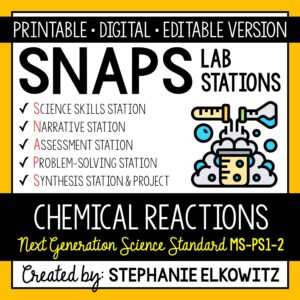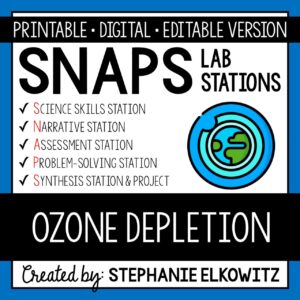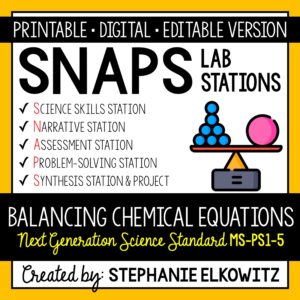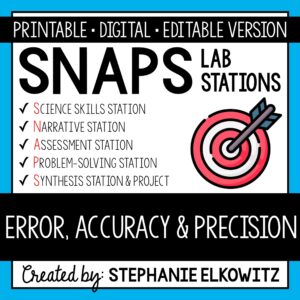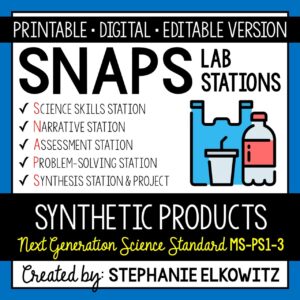MS-LS1-2 Cell Transport Lab
$7.00
An engaging lab activity designed to enhance students’ understanding of passive and active transport and the selective permeability of cell membranes. Aligned with MS-LS1-2.
Description
MS-LS1-2 Cell Transport Lab Preview
SNAPs Lab Stations Activities require students to use science, math, literacy, problem-solving and engineering skills. They are designed to enhance students’ understanding of scientific concepts and help students apply scientific ideas to the real world. Each station activity promotes skills so to develop students into proficient and competent scientific thinkers.
SNAPs lab activities have five components:
• Science Skills Station to develop science skill proficiency
• Narrative Station to build science literacy
• Assessment Station to evaluate learning and understanding
• Problem-Solving Station to foster engineering design
• Synthesis Station and Project to inspire higher-order learning
DIGITAL LABORATORY – DISTANCE LEARNING & DIGITAL CLASSROOMS
• This lab is offered in a digital format to support digital classrooms & distance learning.
• The digital lab activity is designed to work with Google Slides and Microsoft PowerPoint
• The digital lab activity CANNOT be edited. However:
– Students can manipulate text boxes
– Students can create tables, graphs and diagrams
– Students can insert images and drawings
GOOGLE FORM ASSESSMENT STATION
• The assessment station is offered as a self-grading Google Form.
• Questions are all short answer and are 100% editable.
• Suggestions for use are included in the download.
DISTANCE LEARNING COMPATIBILITY
SNAPs lab activities are rated for their ease with distance – independent learning. Refer to the preview for more information about how well this laboratory works in a fully digital classroom and with distance learning.
EDITABLE DOCUMENTS
This download includes an editable word document (docx file) of all lab components:
• Pre-Lab and Post-Lab Activities
• The Lab Overview
• Lab Station Activities and Questions
• Directed Synthesis Project (when applicable)
Important Notes:
• Diagrams, illustrations, tables and graphs essential to lab activities are included
• Illustrative clipart is NOT included
• Editable documents and rubrics are included with the FREE SNAPs Setup Guide
Editable files allow you to:
• Edit the scope of the activities so to suit your students’ needs
• Edit the materials required based on resource availability
• Create single-period “mini-labs” using activities at the individual skills stations
The activities at each station in this lab are detailed below.
Cell Transport Lab Stations Activity Learning Objectives
1. Compare and contrast passive and active transport.
2. Investigate the selective permeability of cell membranes.
3. Observe the process of osmosis.
4. Discuss specific types of passive transport, including [simple] diffusion, facilitated diffusion and osmosis.
5. Discuss specific types of active transport, including transmembrane pump transport, endocytosis and exocytosis.
6. Discuss the role of ATP in active transport.
7. Develop models to study passive and active transport.
8. Define and discuss problems caused by diseases that affect the transport of substances into and out of human body cells.
Science Skills Station
Students will conduct two activities at this station. In the first activity, students will build a “model cell” with simple and complex sugars. They will use the model to investigate the passive transport of substances of varying molecular sizes. In the second activity, students will observe osmosis in a plant cell. They will observe how the concentration of solute and solvent affects the movement of water into and out of plant cells.
Narrative Station
Students will read a passage about passive transport and active transport. They will learn about different types of passive and active transport. Students will watch a video with animations of these types of transport.
Assessment Station
At this station, students will answer questions about cell transport. Students must employ lower, mid and higher order thinking skills to answer these questions.
Problem-Solving Station
In the first activity, students will develop models that illustrate different types of passive and active transport. They will use these models to evaluate active and passive transport. In the second activity, students will identify and study problems caused by diseases (cystic fibrosis and diabetes type 2) in which the transport of materials into and out of cells is dysfunctional.Synthesis Station
Synthesis Station
Students will compose a CER (claim-evidence-reasoning) report to summarize the lab. Students are provided the claim statement and must support the claim with observations, data and other information gathered in the lab. Students will explain how the evidence supports the claim using scientific reasoning.
Synthesis Project
Students will have a choice of 11 projects. Refer to the SNAPs Lab Stations Best Practices and Setup Guide for directions and suggestions on how to conduct the project.
This download includes:
• A pre-lab assignment and post-lab reflection
• Directions and questions for each lab station
• Student recording sheets
• Teacher Key
Additional Materials Required:
2 Computers or tablets
5 600 mL beakers
1 1000 mL beaker
Cornstarch
Dextrose
Benedicts solution
Lugol’s iodine solution
4 droppers
String or dental floss
Sandwich Ziploc bag (1 per group)
Test tubes (2 per group)
Test tube holder
Hot plate
Red onion
Glass slide (1 per group)
Coverslip (1 per group)
Light microscope
Salt water solution
Distilled water
Tweezers
Paper towels
Colored pencils
LINKS TO VIDEOS
This laboratory requires internet to access videos. Videos are hosted on SafeShare.TV so to safely watch and share educational YouTube videos without ads, comments and other distractions. Shortened and full link(s) to SafeShare.TV included. Full link to original YouTube video(s) included.
NEXT GENERATION SCIENCE STANDARDS
This laboratory satisfies NGSS MS-LS1-2. It combines the three dimensions of science learning – science and engineering practices, disciplinary core ideas and crosscutting concepts – to meet the standard. This lab also makes interdisciplinary connections to STEM, Math CCSS and ELA CCSS to build the appropriate skills.
TERMS OF USE
• All rights reserved by Stephanie Elkowitz.
• This product is to be used by the original purchaser only.
• Intended for classroom and personal use only.
• Copying for more than one teacher, classroom, department, school, or school system is prohibited.
• This product may not be distributed or displayed digitally for public view.
• Failure to comply is a copyright infringement and a violation of the Digital Millennium Copyright Act (DMCA).




